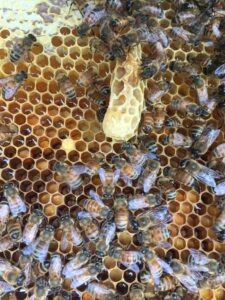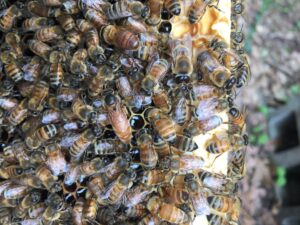My phone, and my colonies, are buzzing. The phone with questions, the latter with bees. Here are some things I suggest you bear in mind this time of year for colonies located in climates similar to SW Michigan. Yes, this is a long post. There’s a lot going on in a colony this time of year!
Caution: spring has had fits and starts, and when your colony was installed and whether it was a nuc or a package plays a huge role in its progress. Thus, I’m refraining from saying “here’s about where they should be build-out wise” because of the variances. Instead, I’m just sharing Q&A from the last few weeks.
Good looking queen, but verify that she’s laying one egg / cell and predominantly worker bees, not drones. Thanks Dr. Stephanie for the picture..
The major thing this time of year is to ensure you are queenright – each and every time you’re in the hive. (See previous blogs for a discussion on queenright. Finding the queen isn’t enough, and you don’t always need to find the queen.)
How often should I check my hive?
If you’re queenright, you can go about every two weeks. However, as a newbee, you want to understand, learn, study. Weekly—weather permitting—is very acceptable.
And if there’s something weird going on, you need to monitor it … but never move a frame faster than a bee can walk because you don’t want to squish the queen!
Should I keep feeding?
I recommend feeding as long as they’ll take it, and they may wax and wane on that. I had the privilege of hearing Dr. Roger Hoopingarner, MSU, speak recently. He said there is a bit of a dearth after the dandelions and fruit tree blooms are gone, so it is important to have 1:1 sugar syrup available for first year colonies.
If they slowed down, you may want to see if they’re interested again in a bit as the dandelions and other blooms decline. Not all flowering shrubs and trees are a buffet for bees—honeybees don’t have the right proboscis for obtaining nectar from some of them.
My bees are all in the top box … why?
Argh. Why do you have a “top box?” Unless you have an early installed, high production nuc, most colonies probably don’t need a new box to work yet. The bees are likely at the top of the top box because in these recently chilly days and quite chilly nights, that’s where the warmth is. If your feeder is at the top, that may have the nursery up there as well for convenience.
You don’t want to provide too much room because of heat issues and patrolling against predators. Don’t add the next box until they’re ready.
When do I add the next box?
I’m an engineer by training; I love black and white answers. But, there are very, very few of those in beekeeping. Here are some guidelines. My answer is based on 10-frame deep Lang equipment; adjust accordingly for 8-frame, medium, etc.
If it is about time for the next box, when you open the hive you should find:
- A queen laying a good brood pattern
- Predominantly worker brood on 3-5 frames (both sides) in various stages of development (eggs, larva, capped with a light color (newer) through practically chocolate-colored caps). That much brood means the population is going to at least double within a few weeks.
On a by-frame basis:
- At least 50% of the frames are nearly all drawn (and most of those are nearly full with brood or resources)
- Work on another 20-30% is well underway, complete with more bees than you can easily count on them, and bees loosely covering most of the surface area
- Any remaining frames, while perhaps nothing is apparent, have several dozen bees patrolling/working them.
This time of year it is generally better to err on the side of giving them room (ie, the next box) prematurely, as they’re in “go” mode and wanting to expand. However, winter returns next week … so that’s sort of a trade-off because you want them to stay warm.
I have a screened bottom board. When do I pull the debris board? And why is it called a debris board?
As background, some hive configurations have a screened bottom board and a removable, often plastic-coated or plastic insert to block wind / keep in warmth. You’ll find out why it is called a debris board when you remove it! J It collects pollen, dead mites, the debris that falls from the bees as they bring in stores and clean themselves.
The weather is predicted to be unseasonably cool again next week. I’d leave that debris board in until we have overnight temperatures consistently about 60 degrees F. or higher.
My bees aren’t working the second box and my bottom box is full. (This is from a second year beekeeper with a bottom box that has five frames with various stages of brood, and another five filled with leftover honey from last year.)
Sometimes bees are hesitant to begin working up in a new area, especially if the frames were untouched by bees or are plastic. So:
- Ever-so-carefully pull a frame or two of brood from the bottom box. Position the frames (from the bottom) in the top box over where the brood nest is in the bottom.
- Carefully push the bottom’s remaining frames together and add more to the sides to the bottom box to get back to your 10 (or 8). If you’re adding previously untouched frames, it is always helpful to spritz them with sugar syrup.
- Add the remaining frames to the top box to get to 10 (or 8). Again, spritz any new ones.
- Add the second box. This gets them “working up” and keeps the brood nest together for warmth and efficiency.
I got ants all over the inner cover, and swimming (and drowning) in the feeder.
Cinnamon deters ants, and doesn’t seem to bother bees much. When we have ant issues, I liberally use cinnamon around the hive on the ground (weather permitting—I make a ring) and / or on the inner cover to keep them from crawling into my top feeders.
What about this Varroa mite thing?
It is potentially a huge, real problem. I understand that a first year beekeeper (and even a ninth year beekeeper!) is continually assaulted with challenges and new things to learn, but you got to deal with this issue.
I will be sharing an expert’s suggestions in a few weeks.
I swear I have fewer bees now than when I got my package two weeks ago!
One of my mentors said the one thing he wished newbees understood was bee math. I had to laugh. Most of us don’t understand regular math … not to mention bee math!
His point though is quite valid. Understanding the key events of the life cycle explains much. For example, a package comes with about 10,000 bees in various stages of their 42 days.
After the package is installed, it may be about a week before the queen begins to lay.
Egg to worker bee is 21 days … and the bees that came with the package are dying off from old age and foraging accidents, and there are no replacements yet.
So yes, depending upon the age of the bees in the package you received, you could lose lots of bees under natural circumstances before new bees emerge. That’s why feeding is so critical, and keeping the size of the hive appropriate for warmth.
Found this queen cell (and I have a queen.) Should I be worried?

Thanks to Dr. Stephanie for such an excellent picture of a queen cell! Yep, that’s a queen cell.
They are building a new queen. Reasons include:
- They’re crowded and thinking of swarming
- The current queen is faulty (laying unsatisfactorily (not a good pattern, not a good quantity, or they are removing lots of brood they’ve determined to be defective.)
- Or, things with that queen are fine, but they don’t realize it and are replacing her. A theory behind package bees requeening almost immediately is that because a package is composed of a bunch of bees shaken in to the shipping box from various hives, the age distribution might be off. They might not have the expected distribution of age / roles and they’re blaming her … even though it isn’t her fault … and are working to replace her.
However, the major thing this time of year is to ensure you are queenright – each and every time you’re in the hive. (See previous blogs for a discussion on queenright. Finding the queen isn’t enough, and you don’t always need to find the queen.)
As always, what I’m sharing are just my thoughts and insights. Read, research, study–and call or email if I may help.

